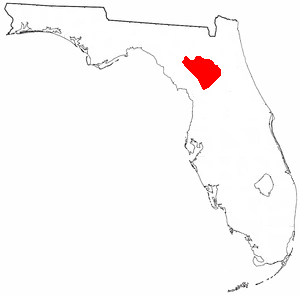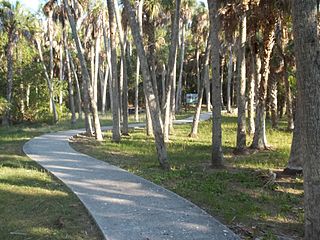
Pine Island Sound is located in Lee County, Florida, lying between Pine Island and the barrier islands of Sanibel Island, Captiva Island, North Captiva Island and Cayo Costa, which separate the Sound from the Gulf of Mexico. The Sound connects to Gasparilla Sound and Charlotte Harbor to the north, and to San Carlos Bay and the Caloosahatchee River to the south. The Sound is conterminous with the Pine Island Sound Aquatic Preserve, which was established in 1970 and consists of 54,000 acres (220 km2) of submerged land. Important habitats in the Sound include mangroves, seagrasses, salt marshes, oyster communities, tidal flats and sponge beds. All animals in and around Pine Island sound, including mollusks, fish, birds and mammals, are affected by periodic outbreaks of red tide. The Sound is relatively shallow in many locations, and boaters are cautioned to utilize up-to-date charts and tide tables.

Devil's Millhopper Geological State Park is a Florida state park located in the north-westernmost part of Gainesville, Florida, off County Road 232, also known as NW 53rd Avenue and Millhopper Road, northwest of the University of Florida.

The Weeden Island cultures are a group of related archaeological cultures that existed during the Late Woodland period of the North American Southeast. The name for this group of cultures was derived from the Weedon Island site in Old Tampa Bay in Pinellas County.

There are more than 1,800 properties and districts listed on the National Register of Historic Places in Florida. They are distributed through 66 of the state's 67 counties. Of these, 42 are National Historic Landmarks.
This National Park Service list is complete through NPS recent listings posted February 9, 2024.

Crystal River State Archaeological Site is a 61-acre (250,000 m2) Florida State Park located on the Crystal River and within the Crystal River Preserve State Park. The park is located two miles (3 km) northwest of the city of Crystal River, on Museum Point off U.S. 19/98.

Spiro Mounds is an Indigenous archaeological site located in present-day eastern Oklahoma. The site was built by people from the Arkansas Valley Caddoan culture. that remains from an American Indian culture that was part of the major northern Caddoan Mississippian culture. The 80-acre site is located within a floodplain on the southern side of the Arkansas River. The modern town of Spiro developed approximately seven miles to the south.

Horr's Island is a significant Archaic period archaeological site located on an island in Southwest Florida formerly known as Horr's Island. Horr's Island is on the south side of Marco Island in Collier County, Florida. The site includes four mounds and a shell ring. It has one of the oldest known mound burials in the eastern United States, dating to about 3400 radiocarbon years Before Present (BP). One of the mounds has been dated to as early as 6700 BP. It was the largest known community in the southeastern United States to have been permanently occupied during the Archaic period.

The Cades Pond culture is defined as a Middle Woodland Southeast period archaeological culture in north-central Florida, dating from around 100 to 600 CE.

The Boulware Springs Water Works is a historic site in Gainesville, Florida, United States. It is located at 3400 Southeast 15th Street. On June 20, 1985, it was added to the U.S. National Register of Historic Places. It is also the western terminus of the Gainesville-Hawthorne State Trail.

The Madira Bickel Mound State Archaeological Site is an archaeological site on Terra Ceia Island in northwestern Palmetto, Florida, United States. It is located on Bayshore Drive, west of U.S. 19, a mile south of I-275. On August 12, 1970, it was added to the U.S. National Register of Historic Places. It is also a Florida State Park.
Mound Key Archaeological State Park is a Florida State Park, located in Estero Bay, near the mouth of the Estero River. One hundred and thirteen of the island's one hundred and twenty-five acres are managed by the park system. It is a complex of mounds and accumulated shell, fish bone, and pottery middens that rises more than 30 feet above the waters of the bay.
The Pineland Archeological District is a U.S. historic district located on Pine Island, near Pineland, Florida, and next to Pine Island Sound. The site was occupied by people of the Caloosahatchee culture, known as the Calusa in historic times, from 500 BCE until after 1700. The site includes shell and sand mounds and other structures and prehistoric canals and artificial lakes. It also includes structures from the late 19th and early 20th centuries.
The Turner River Site (8CR8) is an archaeological site in the Ten Thousand Islands region of Everglades National Park, in Florida. It is listed on the U.S. National Register of Historic Places.
The Josslyn Island Site is an archaeological site composed of a shell mound in Lee County, Florida, United States.
The Green River Shell Middens Archeological District is a historic district composed of archaeological sites in the U.S. state of Kentucky. All of the district's sites are shell middens along the banks of the Green River that date from the later portion of the Archaic period. Studies of this assemblage of sites were critical in the development of knowledge of the Archaic period in the eastern United States.

Nocoroco is the site of a Timucuan village located on the Tomoka River, in Tomoka State Park. The park is located two or three miles north of Ormond Beach, Florida on North Beach Street.

Historic Spanish Point is a 33-acre (13 ha) museum and environmental complex located in Osprey, Florida at 337 North Tamiami Trail. The museum includes an archeological exhibit of a prehistoric shell mound known as a midden, a turn-of-the-century pioneer homestead historic house museum, a citrus packing house, a chapel, boatyard, gardens, and nature trails.

Shell works are large and complex assemblages of shell found in southwest Florida. Shell works include mounds and other deposits, with features described as borrow pits, canals, causeways, cisterns, crescents, sunken plazas, ponds, ramps, raised platforms, ridges, rings, walls, and "water courts". The largest shell works were constructed during the Woodland period in southwest Florida, from Charlotte Harbor to the Ten Thousand Islands, including Estero Bay.
Minim Island Shell Midden (38GE46) is a historic midden and archaeological site located near Georgetown, Georgetown County, South Carolina. The site consists of prehistoric midden deposits of shellfish remains, floral and faunal remains, and interred human burials. Cultural materials in the form of ceramics and lithics occur throughout the midden. These deposits are concentrated for a distance of about 100 feet along the shoreline of the Intracoastal Waterway.















